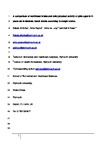A comparison of nutritional intake and daily physical activity of girls aged 8-11 years old in Makkah, Saudi Arabia according to weight status
| dc.contributor.author | Al-Kutbe, R | |
| dc.contributor.author | Payne, A | |
| dc.contributor.author | de Looy, A | |
| dc.contributor.author | Rees, GA | |
| dc.date.accessioned | 2017-06-26T10:02:45Z | |
| dc.date.available | 2017-06-26T10:02:45Z | |
| dc.date.issued | 2017-06-21 | |
| dc.identifier.issn | 1471-2458 | |
| dc.identifier.issn | 1471-2458 | |
| dc.identifier.other | 592 | |
| dc.identifier.uri | http://hdl.handle.net/10026.1/9549 | |
| dc.description.abstract |
BACKGROUND: Obesity rates in Saudi Arabia are amongst the highest in the world. It is known that teenage girls are less active than teenage boys, but less is known about the diet and activity patterns in younger girls. Therefore this study sought to investigate dietary intake and daily physical activity in girls aged 8-11 years old in Saudi Arabia. METHODS: This was a cross- sectional observational study conducted in seven schools across the city of Makkah. A total of 266 girls had anthropometric measurements taken including height, weight, waist circumference and body fat estimations. Dietary assessment using a 4 day unweighed diet diary was undertaken in 136 of these participants, and 134 agreed to monitor their physical activity for the 4 days using an accelerometer. After exclusion for under-reporting, 109 remained in the dietary analysis and 78 in the physical activity analyses. Differences in means between BMI groups were determined using one-way ANOVA with post hoc Tukey test. Multivariable linear regression analysis was performed to look at the effect of multiple variables on body weight. RESULTS: A total of 30% of participants were classified obese or overweight. There was a significant difference in the mean daily energy intake between the BMI groups with the obese group having the highest energy, fat, carbohydrate and protein intake (obese group: 2677 ± 804 kcal/d; healthy weight group: 1806 ± 403 kcal/d, p < 0.001), but the percentage contribution of the macronutrients to energy intake remained the same across the BMI groups. There were no differences in number of steps taken per day or time spent in moderate to vigorous intensity exercise according to BMI category. Most of the girls did not meet daily physical activity guidelines (5969 to 6773 steps per day and 18.5 - 22.5 mins per day of moderate to vigorous activity). Multiple linear regression showed that energy intake positively predicted body weight (Beta = 0.279, p =0 .001), whereas, total energy expenditure per kg of body weight and family income had a significant negative influence on body weight (Beta = -0.661, p < 0.001; -0.131, p = 0.028 respectively). CONCLUSIONS: The results of this cross sectional analysis suggest that obesity in girls aged 8-11 years is linked to excessive energy intake from all macronutrients and the majority of girls in all weight categories are inactive. Research should be conducted to further investigate causal relationships in longitudinal studies and develop interventions to promote dietary change and activity that is culturally acceptable for girls in Saudi Arabia. | |
| dc.format.extent | 592- | |
| dc.format.medium | Electronic | |
| dc.language | en | |
| dc.language.iso | en | |
| dc.publisher | BioMed Central | |
| dc.subject | Dietary habits | |
| dc.subject | Energy intake | |
| dc.subject | Girls | |
| dc.subject | Nutrient intake | |
| dc.subject | Physical activity | |
| dc.subject | Saudi Arabia | |
| dc.title | A comparison of nutritional intake and daily physical activity of girls aged 8-11 years old in Makkah, Saudi Arabia according to weight status | |
| dc.type | journal-article | |
| dc.type | Article | |
| plymouth.author-url | https://www.ncbi.nlm.nih.gov/pubmed/28637444 | |
| plymouth.issue | 1 | |
| plymouth.volume | 17 | |
| plymouth.publication-status | Published | |
| plymouth.journal | BMC Public Health | |
| dc.identifier.doi | 10.1186/s12889-017-4506-2 | |
| plymouth.organisational-group | /Plymouth | |
| plymouth.organisational-group | /Plymouth/Faculty of Health | |
| plymouth.organisational-group | /Plymouth/Faculty of Health/School of Biomedical Sciences | |
| plymouth.organisational-group | /Plymouth/Research Groups | |
| plymouth.organisational-group | /Plymouth/Research Groups/Institute of Health and Community | |
| plymouth.organisational-group | /Plymouth/Research Groups/Institute of Translational and Stratified Medicine (ITSMED) | |
| plymouth.organisational-group | /Plymouth/Research Groups/Institute of Translational and Stratified Medicine (ITSMED)/CBR | |
| plymouth.organisational-group | /Plymouth/Research Groups/Plymouth Institute of Health and Care Research (PIHR) | |
| plymouth.organisational-group | /Plymouth/Users by role | |
| plymouth.organisational-group | /Plymouth/Users by role/Academics | |
| dc.publisher.place | England | |
| dcterms.dateAccepted | 2017-06-14 | |
| dc.identifier.eissn | 1471-2458 | |
| dc.rights.embargoperiod | No embargo | |
| rioxxterms.versionofrecord | 10.1186/s12889-017-4506-2 | |
| rioxxterms.licenseref.uri | http://www.rioxx.net/licenses/all-rights-reserved | |
| rioxxterms.licenseref.startdate | 2017-06-21 | |
| rioxxterms.type | Journal Article/Review | |
| plymouth.oa-location | https://bmcpublichealth.biomedcentral.com/articles/10.1186/s12889-017-4506-2 |



